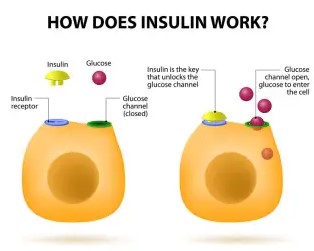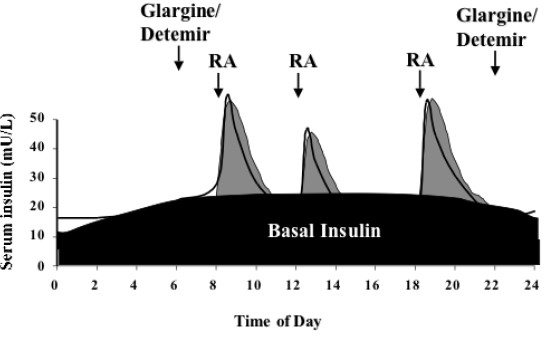Insulin is an essential hormone for regulating blood sugar levels in people with diabetes. It comes in two forms: basal and bolus insulin.
While both types of insulin are used to manage blood glucose levels, they have important differences in terms of how they work and when they should be administered. In this blog, we’ll discuss the differences between basal and bolus insulin and explain how each type can be used to effectively manage diabetes.
Types of insulin: exploring the different types of insulin

When managing diabetes, insulin plays a crucial role in keeping blood sugar levels in check. But did you know that there are different types of insulin?
Basal insulin is a background insulin that works to keep your blood sugar levels in a healthy range throughout the day, while bolus insulin is a mealtime insulin that is taken before or after a meal to regulate your blood sugar levels after eating. Knowing the difference between these two types of insulin can help you better manage your diabetes and keep your blood sugar in a safe range.
Types of insulin: exploring the different types of insulin

Basal insulin is a long-acting form of insulin that helps to keep your blood sugar levels steady throughout the day. It is one of two types of insulin: basal and bolus.
Both types of insulin are important for helping to manage diabetes, but basal insulin has some unique benefits. The most significant benefit of basal insulin is that it provides a steady and consistent level of control over blood sugar levels throughout the day.
This is especially helpful for people with diabetes who need to monitor their blood sugar levels multiple times a day. In addition to providing better control, basal insulin also helps to reduce the risk of hypoglycemic episodes, which can be dangerous.
However, there are also some drawbacks to using basal insulin. It does not provide the same level of flexibility that bolus insulin does, as it cannot be adjusted to address sudden spikes in blood sugar levels. Additionally, it can be more difficult to time the doses of basal insulin, as it needs to be taken at the same time each day in order to be effective.
Overall, basal insulin is a useful tool for managing diabetes, but it is important to understand its benefits and drawbacks and to use it in conjunction with other treatments. With careful timing and monitoring, it can be a good way to keep blood sugar levels steady throughout the day.
Benefits of bolus insulin: the pros and cons of bolus insulin

Bolus insulin is a type of insulin used to help people with diabetes manage their blood sugar levels. It is usually taken in addition to a long-acting or basal insulin, which works to keep your blood sugar levels stable throughout the day.
Bolus insulin is taken in response to high blood sugar levels, and so helps to bring your levels back to normal. The primary difference between basal and bolus insulin is that basal insulin works continuously throughout the day, while bolus insulin is taken in response to an elevated blood sugar level, or to cover a meal. The benefits of bolus insulin include the ability to better manage your blood sugar levels, and the flexibility it provides in terms of meals and food choices.
It also helps to reduce the risk of developing long-term complications from diabetes, such as heart disease and kidney damage. However, bolus insulin can also cause hypoglycemia, or low blood sugar levels, if taken in too large of a dose.
Comparing the two: comparing the benefits and drawbacks of basal and bolus insulin
If you have diabetes, you may be familiar with the two main types of insulin – basal and bolus. While both are important tools in managing your diabetes, it’s important to understand the differences between the two and the benefits and drawbacks of each. Basal insulin is a long-acting insulin that works to keep your blood sugar from rising too high throughout the day.
Basal insulin is a long-acting insulin that works to keep your blood sugar from rising too high throughout the day. Bolus insulin is a short-acting insulin that is used to cover meals or snacks to help keep your blood sugar in a healthy range. Understanding the differences between these two types of insulin can help you better manage your diabetes.
Basal insulin works to provide background insulin throughout the day, helping to lower your blood sugar and prevent it from spiking after meals. This makes it a good choice for those with type 1 diabetes, as it helps control blood sugar levels between meals and overnight. It can also be used to adjust your insulin needs based on your activity level.
However, it can take up to two hours to reach its peak effect and can cause nighttime hypos (low blood sugar). Bolus insulin is a fast-acting insulin that is used to cover meals or snacks.
It works quickly to lower your blood sugar and peaks within 30 minutes of injection. This makes it a better choice for those with type 2 diabetes, as it helps control post-meal blood sugar spikes. Bolus insulin can also be used to correct high blood sugar levels. However, it can be difficult to adjust the dose and timing of bolus insulin to match your food intake.
Tips for managing diabetes with insulin: what to consider when taking insulin
When it comes to managing diabetes with insulin, there are two types of insulin to consider: basal and bolus. Basal insulin is designed to maintain a consistent level of glucose in the body throughout the day. This type of insulin is typically taken once or twice a day, and it works to keep your body’s glucose levels stable.
On the other hand, bolus insulin is taken when your body needs an additional boost of glucose. This type of insulin is often taken 15 minutes before meals to help manage your glucose levels before eating.
It is important to understand the differences between these two types of insulin and how they work together to keep your glucose levels in check.
Conclusion
Basal and bolus insulin are two different types of insulin used to treat diabetes. Basal insulin is a long-acting insulin that works slowly and consistently throughout the day, providing a steady background insulin level. Bolus insulin is a rapid-acting insulin that is used to cover meals and correct high blood sugar levels.
While both types of insulin can be effective in controlling blood sugar levels, they work in different ways and should be used in accordance with your doctor’s recommendations.

